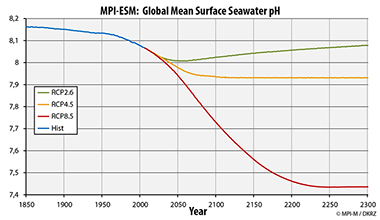With the onset of industrialization, the ocean began absorbing considerable amounts of excess CO2 that humans contributed to the atmosphere. The chemical composition of the sea water promotes this process, but causes changes in its chemical balance: the pH level is dropping. This process, called ocean acidification, is currently underway and will continue to accelerate during the decades to come, depending on the continued emissions of CO2.
Our projection for the pessimistic RCP8.5 Scenario shows that all regions of the world’s oceans would be affected by the acidification, with the lowest values occurring in higher latitudes and pole regions. By chronologically following the development of the global pH average (shown as moving marker on the color scale), one can clearly see the acceleration of the rate of change by the end of the century. While the pH level only dropped by approximately 0.1 units from the beginning of industrializaion to today, it is expected to decrease by another 0.4 units by the end of the century.
 In the long run, this trend could even gain strength for the case of increasing emissions such as in RCP8.5, and the pH value would further sink as shown in the graph on the right. In the case of emissions following the less severe scenario RCP4.5, the pH value would not sink as strongly and stabilize at about 7.9 – a value approximately 0.15 more acidic compared to the state of today, though. For RCP2.6, a slow recovery in the pH value is simulated for the time beyond 2050. However, even for this very optimistic scenario, it would take about 200 years to return to today’s level.
In the long run, this trend could even gain strength for the case of increasing emissions such as in RCP8.5, and the pH value would further sink as shown in the graph on the right. In the case of emissions following the less severe scenario RCP4.5, the pH value would not sink as strongly and stabilize at about 7.9 – a value approximately 0.15 more acidic compared to the state of today, though. For RCP2.6, a slow recovery in the pH value is simulated for the time beyond 2050. However, even for this very optimistic scenario, it would take about 200 years to return to today’s level.
At the moment, the impacts of ocean acidification on marine ecosystems are being investigated, with experimental observations showing reproduction defects, missing or fragile shells, and possible shifts in communities of species. This represents a challenge to the entire ocean food chain. Since the pH level would change at a rate 100 times faster than ever recorded in geological history, marine life is expected to face an even greater challenge.
Literature:
The global ocean biogeochemistry model HAMOCC: Model architecture and performance as component of the MPI-earth system model in different CMIP5 experimental realizations
Tatiana Ilyina, Katharina D. Six, Joachim Segschneider, Ernst Maier-Reimer, Hongmei Li, Ismael Núñez-Riboni
in: Journal of Advances in Modeling Earth Systems, 2013, DOI: 10.1002/jame.20017
